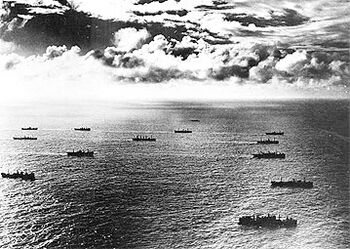Nuadan Campaign
| Nuadan Campaign | |||||||
|---|---|---|---|---|---|---|---|
| Part of the Western Theater of the Siduri War | |||||||
 A convoy in the Nuadan Ocean | |||||||
| |||||||
| Belligerents | |||||||
| Common Axis |
| ||||||
| Commanders and leaders | |||||||
|
|
| ||||||
| Casualties and losses | |||||||
|
46,000 sailors 274 warships 1,175 cargo vessels 855 aircraft |
71,000 sailors 417 warships 2,115 cargo vessels 1,455 aircraft | ||||||
The Nuadan Campaign was a naval campaign fought between the Common Axis and the Inner Sphere in the Nuadan Ocean during the Siduri War. The Nuadan Campaign is usually considered to be part of the Western Theater and was fought primarily by the Cacertian Royal Navy and the Navy of the Syaran Republic with additional involvement from the navies of Tennai, Mansuriyyah, and the Shirvani Dominion.
The Nuadan Ocean held strategic significance for both sides. For the Cacertians this was the only effective means of importing raw materials and resources from west Eracura, as the Sundering Sea had been effectively closed off to Common Axis aligned shipping in the western mouth of the Sundering. Merchant vessels had to instead sail south towards the Cacertian territory of Andria in the Sabri Sea to circumnavigate the Siduri continent, passing near the Ossorian territory of Hemar, West Aeoteroa, and Nawalupa in what became known as the Nuadan Triangle, where Syaran warships would often try to intercept Common Axis shipping. In response the Cacertians launched numerous commerce raiders into the Nuadan to interfere with the Inner Sphere's trade with west Eracura. A second strategic goal was supporting Common Axis forces in Mansuriyyah through a regular stream of supplies and reinforcements by sea.
The Inner Sphere aimed to deny access to the Nuadan to the Common Axis fleets, a goal which was to be achieved by the destruction of the Cacertian naval presence at the Andria Protectorate. Additional objectives included protecting Common Axis shipping and aiding ground operations in Mansuriyyah. The campaign began officially with Operation Charybdis, a Syaran air and sea attack on Andria. The destruction of the Andria facilities allowed the Syarans to initially operate with near-impunity in the Nuadan, resulting in the destruction of the Mansuri fleet at large during the Battle of the Mansuri Sea. Cacertian forces retaliated with the Attack on Moddra a month later. By 1935 however the Cacertian Royal Navy had re-established its presence in the Nuadan with support from the Royal Tennaiite Navy and begun contesting the Inner Sphere sea lanes while simultaneously raiding Inner Sphere shipping. In the summer of 1935 the Syaran Navy launched an invasion of the Mansuri island of Yalunji, but failed to capture the island. Both sides launched serious raids against commerce shipping resulting in the loss of dozens of vessels on both sides.
By 1936 it was clear to the Syaran Admiralty that the Inner Sphere was failing to keep pace with Common Axis naval production and operations, leading to a second attack on Andria in February 1936 that resulted in a Syaran defeat. A Syaran victory in the Second Battle of the Mansuri Sea failed to turn the tide of the campaign, and the success of Operation Uphold in September 1936, coupled with reversals on land, forced the Syaran National Fleet to conduct a desperate attack on Andria culminating in a decisive Common Axis victory at the Battle of the Sabri Sea. The decimation of the Syaran fleet effectively ceded the initiate to the Common Axis, which would continue to grind down the Inner Sphere navy into 1937 and continuing after the withdrawal of the Shirvani Dominion from the war.
Plans for a blockade of Syara were envisioned by the Cacertian Admiralty but never materialized due to logistical and operational limitations. The Syaran Navy nevertheless became increasingly restricted amid a decaying strategic situation, but continued to contest Common Axis fleets operating off the Mansuri and Ruvelkan coasts. The Syaran National Fleet sortied for the last time in December 1937 before being rescinded completely to port in January 1938, which is usually used to mark the end of the campaign. All naval operations ended at the conclusion of the war in February 1938 with the Treaty of Debrecen, after which the Syarans scuttled their own ships a month later.
The Nuadan Campaign was the longest campaign of the Siduri War, at its peak involving nearly 1,000 warships and more than 5,000 commercial vessels. Much of the fighting in the campaign took place in the form of single ship or division sized engagements by destroyers, corvettes, convoy escorts, and auxiliary cruisers, though larger capital ships often served as raiders including the Syaran Moddra-class battlecruisers and the Cacertian Amika Carpio-class battleships. Capital ships often played significant roles as surface raiders and their feats, such as the Divide Dash, earned wide spread public attention.